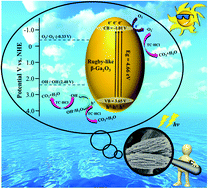Photocatalytic degradation of tetracycline hydrochloride over rugby-like β-Ga2O3 with a 3D hierarchically assembled porous structure for environmental remediation
Abstract
A novel rugby-like β-Ga2O3 photocatalyst with a 3D hierarchically assembled porous structure was successfully constructed through a facile precipitation–calcination method. The synthesized Ga2O3 materials were used for the photocatalytic degradation of tetracycline hydrochloride (TC·HCl) and the effects of calcination temperature on photocatalytic activity were discussed. The conversion of TC·HCl over Ga2O3-900 was 99.0% after 25 min of UV-light irradiation, which was higher than those of commercial Ga2O3 (71.2%) and P25 (82.9%). The best photocatalytic activity of Ga2O3-900 could be attributed to its large specific surface area, intrinsic electronic properties and stable 3D hierarchically assembled porous structure. Based on the liquid chromatography quadrupole time-of-flight mass spectrometry (LC-QTOF-MS) analysis, the photocatalytic mechanism of Ga2O3 and feasible degradation pathway of TC·HCl were proposed. We believe that the present study can exploit an effective avenue to design photocatalysts with 3D hierarchical porous structures to meet ever-increasing environmental remediation requirements.



 Please wait while we load your content...
Please wait while we load your content...